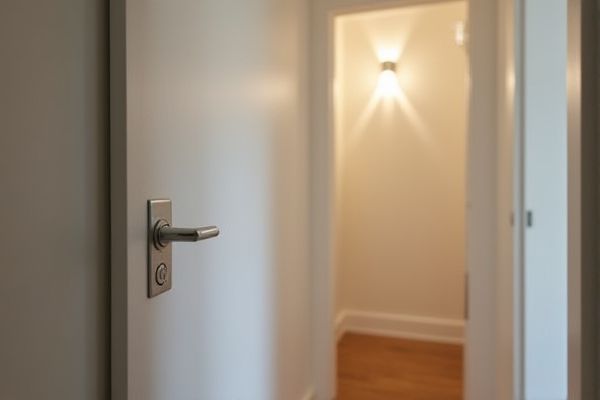
A closet light sensor automatically turns the light on when motion is detected and off after no motion, enhancing energy efficiency compared to a manual switch that requires you to physically toggle it. Explore the rest of the article to understand which option best suits Your needs and how each impacts convenience and electricity usage.
Table of Comparison
| Feature | Closet Light Sensor | Manual Switch |
|---|---|---|
| Operation | Automatically detects motion or light levels to turn on/off | Requires manual on/off switching |
| Energy Efficiency | High - reduces energy waste by auto shut-off | Depends on user behavior; potential for lights left on |
| Installation | Requires sensor and wiring or battery setup | Simple wiring or replacement of existing switch |
| Cost | Higher initial cost due to sensor technology | Lower initial cost |
| Maintenance | Sensor calibration and occasional battery replacement | Minimal, mostly switch replacement if broken |
| Convenience | Hands-free operation; ideal for quick access | Manual operation; requires physical action |
| Reliability | Depends on sensor sensitivity and placement | Consistent, no dependency on detection |
Introduction to Closet Lighting Solutions
Closet light sensors offer automated illumination by detecting motion or ambient light changes, enhancing convenience and energy efficiency compared to traditional manual switches. These sensors reduce the need to physically operate a switch, providing hands-free lighting activation that benefits small or dimly lit spaces. Manual switches remain a straightforward, cost-effective choice but lack the smart functionality and energy-saving features of sensor-based systems.
Overview of Closet Light Sensors
Closet light sensors automatically detect motion or ambient light levels to turn the light on or off, enhancing energy efficiency and convenience. These sensors reduce the need to manually operate switches, providing hands-free illumination that activates only when you access the closet. Compared to manual switches, closet light sensors offer a modern, smart lighting solution that adapts to your usage patterns and conserves electricity.
Manual Switch Systems Explained
Manual switch systems in closet lighting rely on physical toggles or buttons that users activate to control illumination. These systems provide straightforward, immediate lighting control without dependency on ambient conditions or sensor calibration. Their simplicity ensures consistent performance, making them a reliable choice for closets lacking natural light or requiring precise user control.
Key Differences: Sensor vs. Manual Switch
Closet light sensors automatically detect motion and activate the light, providing hands-free convenience and energy efficiency by turning off after inactivity. Manual switches require you to physically toggle the light, offering direct control but increasing the risk of leaving the light on unintentionally. Your choice depends on whether you prioritize automation and energy savings or prefer direct, consistent control over your lighting.
Convenience and Ease of Use
A closet light sensor offers superior convenience by automatically turning the light on as soon as you open the door, eliminating the need to fumble for a switch in the dark. Manual switches require deliberate effort to locate and operate, which can be inconvenient if your hands are full or you're in a hurry. Your daily routine becomes smoother with sensor-activated lighting, enhancing ease of use and energy efficiency.
Energy Efficiency and Power Consumption
Closet light sensors use motion detection technology to automatically turn lights on and off, significantly reducing energy consumption by ensuring illumination only when needed. Manual switches rely on human intervention, often leading to lights being left on unnecessarily, increasing power usage. Energy-efficient closet light sensors can reduce electricity costs by up to 30% compared to traditional manual switching systems.
Installation and Maintenance Requirements
Closet light sensors offer easier installation with no need for complex wiring, making them ideal for quick setups, while manual switches generally require more effort for proper electrical connection. Maintenance for light sensors tends to be minimal, often limited to sensor adjustments or occasional battery replacement in wireless models, whereas manual switches might require regular checks for mechanical wear. Your choice depends on whether you prefer low-maintenance automation or a simple, reliable manual control system.
Cost Comparison: Sensor vs. Manual
Closet light sensors typically cost more upfront than manual switches, with average sensor prices ranging from $20 to $50 compared to $5 to $15 for standard switches. Installation costs for sensor lights can also be higher due to wiring complexities and sensor calibration, potentially doubling the labor expense. Your choice should weigh long-term energy savings from sensors against the initial cost difference between these two lighting options.
Best Applications for Each System
Closet light sensors are ideal for small or frequently used spaces where automatic activation enhances convenience and energy efficiency by turning lights on and off based on occupancy. Manual switches excel in larger closets or spaces with irregular usage patterns, allowing users full control over lighting duration and intensity. Each system optimizes lighting based on specific user needs, making sensors best for hands-free operation and switches best for precise manual control.
Choosing the Right Closet Lighting Solution
A closet light sensor offers convenience by automatically turning lights on and off based on motion detection, enhancing energy efficiency and ease of use. Manual switches provide full control over lighting but require you to remember to operate them, which may lead to unnecessary energy consumption. Evaluating your lifestyle and closet usage patterns helps determine whether an automated sensor or a manual switch better suits your needs for optimal lighting management.
 homyna.com
homyna.com